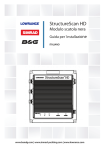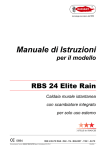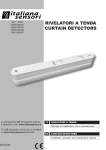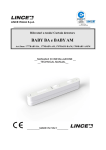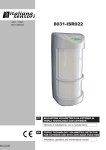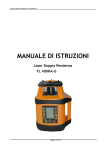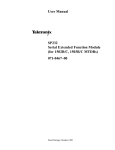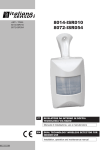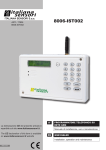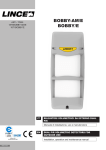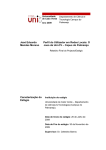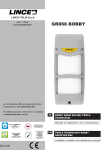Download File istruzioni - Italiana Sensori Presenta
Transcript
ART. / ITEM: 8032-ISR023 8033-ISR024 RILEVATORI A TENDA UNIVERSALI UNIVERSAL CURTAIN DETECTORS IT RILEVATORI A TENDA UNIVERSALI Manuale di installazione, uso e manutenzione EN UNIVERSAL CURTAIN DETECTORS Installation, operation and maintenance manual MADE IN ITALY - Istruzioni originali - - Translation of the original instructions (original instructions in Italian) - INDICE CONTENTS 1.INTRODUZIONE................................................................................................. 2 1.1 CARATTERISTICHE GENERALI............................................................ 2 1.2 CARATTERISTICHE TECNICHE............................................................ 3 1.3 IDENTIFICAZIONE DELLE PARTI.......................................................... 3 1.4 DOTAZIONI DI SERIE............................................................................. 4 2.INSTALLAZIONE............................................................................................... 4 2.1 AVVERTENZE GENERALI...................................................................... 4 2.2 MONTAGGIO DEL RILEVATORE........................................................... 4 2.3 CABLAGGIO DEL RILEVATORE ........................................................... 5 2.4 CONFIGURAZIONE DEL RILEVATORE................................................. 5 2.4.1 Descrizione dei DIP-switch........................................................... 5 2.4.2 Descrizione dei LED..................................................................... 7 2.4.3 Installazione interna/esterna........................................................ 7 2.4.4 Funzione CWS® ........................................................................... 8 2.4.5 Sensibilità PIR.............................................................................. 8 2.4.6 Antimascheramento..................................................................... 8 3. PRINCIPI DI FUNZIONAMENTO....................................................................... 9 3.1 INSTALLAZIONE TIPICA........................................................................ 9 3.2 TARATURA DEL SENSORE................................................................. 10 3.3 DETERMINAZIONE AREA DI COPERTURA........................................ 10 4. MANUTENZIONE E VERIFICHE PERIODICHE.............................................. 11 4.1 PULIZIA ESTERNA DEL RILEVATORE................................................ 11 5. SMALTIMENTO E ROTTAMAZIONE............................................................... 11 5.1 DISINSTALLAZIONE............................................................................. 11 1.INTRODUCTION................................................................................................ 2 1.1 GENERAL FEATURES........................................................................... 2 1.2 TECHNICAL FEATURES........................................................................ 3 1.3 PARTS IDENTIFICATION....................................................................... 3 1.4 STANDARD EQUIPMENT....................................................................... 4 2.INSTALLATION.................................................................................................. 4 2.1 GENERAL PRECAUTIONS.................................................................... 4 2.2 INSTALLING THE DETECTOR............................................................... 4 2.3 DETECTOR WIRING ............................................................................. 5 2.4 DETECTOR SET-UP............................................................................... 5 2.4.1 DIP-switches configuration........................................................... 5 2.4.2 Description of the LEDs................................................................ 7 2.4.3 Outdoor/indoor Installation........................................................... 7 2.4.4CWS® feature............................................................................... 8 2.4.5 PIR sensibility............................................................................... 8 2.4.6Antimasking.................................................................................. 8 3. UNIT FEATURES............................................................................................... 9 3.1 TYPICAL INSTALLATION........................................................................ 9 3.2 SENSOR SETTING............................................................................... 10 3.3 DETERMINING THE DETECTION AREA............................................. 10 4. MAINTENANCE AND PERIODIC CHECKS.................................................... 11 4.1 CLEANING THE EXTERNAL PART OF THE DETECTOR................... 11 5. DISPOSAL AND SCRAPPING......................................................................... 11 5.1DISMANTLING...................................................................................... 11 Le informazioni riportate in questo manuale sono state compilate con cura, tuttavia Italiana Sensori non può essere ritenuta responsabile per eventuali errori e/o omissioni. Italiana Sensori si riserva il diritto di apportare in ogni momento, e senza preavviso, miglioramenti e/o modifiche ai prodotti descritti nel presente manuale. Italiana Sensori pone particolare attenzione al rispetto dell’ambiente. Tutti i prodotti ed i processi produttivi sono progettati con criteri di eco-compatibilità. Il presente articolo è stato prodotto in Italia. The informations in this manual have been issued with care, anyway Italiana Sensori will not be responsible for any errors or omissions. Italiana Sensori reserves the rights to improve or modify the products described in this manual at any times and without advance notice. Italiana Sensori pays particular attention to environment respect. Each product and each process have been designed with ecocompatibility criteria. This product has been made in Italy. 1.INTRODUZIONE 1.INTRODUCTION I rilevatori serie 8032 e 8033 sono stati sviluppati per la protezione di porte e finestre; essi sono rappresentativi del più alto livello tecnologico fra i rilevatori anti intrusione a tripla tecnologia gestiti da microprocessore. Il rilevatore è stato progettato per essere utilizzato con qualsiasi sistema via radio e qualsiasi protocollo di trasmissione. Il profilo snello rende possibile l’installazione tra tapparelle/persiane e finestre. Il rilevatore è composto da due sensori ad infrarosso ed una microonda a 24 GHz; l’antimascheramento è stato progettato utilizzando sensori ad IR attivi che, attraverso le lenti di Fresnel, hanno la capacità di rilevare ostacoli volontariamente apposti sulla lente stessa per impedire il rilevamento (spray, nastro adesivo, carta ecc.). Utilizzando la funzione WIN (Wired Interface Network) è possibile alimentare il dispositivo attraverso l’alimentazione principale, mantenendo la Microonda sempre accesa ed avendo dunque le stesse prestazioni di un rilevatore filare; tramite la funzione WIN è inoltre possibile eliminare l’inibizione dopo la prima rilevazione. The 8032 and 8033 series detectors have been developed for the protection of doors and windows; they represent the highest level of technology for microprocessor-controlled tripletechnology intrusion prevention detectors. The detector has been developed to be combined with any radiobased system and any transmission protocol. The thin profile offers installation between roller shutters/shutters and windows. The detector consist of two infra-red sensors and one 24 GHz microwave; the anti-masking is designed using active IR sensors which, through Fresnel lenses, have the capacity to detect obstacles voluntarily affixed on the lens to prevent detection (spray, adhesive tape, paper, etc.). Using the WIN function (Wired Interface Network) it is possible to power the devices from the mains, keeping the Microwave on and therefore offering the same performance as a wired detector; through the WIN function it is also possible to eliminate inhibition mode after the first detection. 1.1 1.1 • • • • • • 2 CARATTERISTICHE GENERALI Contenitore in policarbonato e lenti di Fresnel resistenti ai raggi UV. Design estetico e meccanico particolarmente curato. Scheda elettronica alloggiata in un compartimento ad elevato grado IP (IP55). Conforme alle norme EN 50131-1 grado 3. Funzione CWS® (Cross Walking Sensibility): permette di discriminare la direzione di attraversamento. Funzione WIN: alimentazione tramite rete principale. • • • • • • GENERAL FEATURES Casing in polycarbonate and Fresnel lenses UV resistant. Carefully developed aesthetic and mechanical design . Electronic board built-in in a compartment matching with the base, provided of a sealing gasket (IP55). EN 50131-1 grade 3 compliant. CWS® (Cross Walking Sensibility): to identify the crossing direction. WIN function: power from the mains. 1.2 CARATTERISTICHE TECNICHE 1.2 TECHNICAL FEATURES 8032-ISR023 8033-ISR024 8032-ISR023 8033-ISR024 Alimentazione 2,35 ÷15 Vcc Consumo Power supply 2.35 ÷15 Vdc 10 µA stand-by 18 mA rilevazione 32 mA consumo massimo Current consumption Banda K Microwave frequncy Frequenza microonda 10 µA stand-by 18 mA detection 32 mA maximum consumption K Band Contatti di allarme, tamper, mascheramento MOS FET relay NC-NO Alarm, masking, tamper contacts Copertura rilevazione Vedere par. 3.3 Motion detection coverage MICROSWITCH Antitamper function Funzione antimanomissione Tempo di allarme 1s IR attivi Antimasking 4 Signal LEDs LED di segnalazione Grado di protezione contenitore See par. 3.3 MICROSWITCH Alarm time 1s Antimascheramento MOS FET relay NC-NO Active IRs 4 Enclosure degree of protection IP 55 IP 55 Classe ambientale Classe III (EN 50131-1) Environmental classification Class III (EN 50131-1) Grado di sicurezza Grado 3 (EN 50131-1) Security grading Grade 3 (EN 50131-1) Contenitore Policarbonato resistente UV Temperatura di esercizio -25 °C ÷ +50 °C Dimensioni vano trasmettitore 90x23x33 mm Dimensioni esterne 256 x 34 x 41 mm Peso 1.3 Casing UV resistant polycarbonate Operating temperature -25 °C ÷ +50 °C Transmitter compartment dimensions 90x23x33 mm External dimensions 256 x 34 x 41 mm Weight (g) 150 g IDENTIFICAZIONE DELLE PARTI 1.3 Vista interna 150 g PARTS IDENTIFICATION Internal view 10 11 12 13 14 CWS 9 Fig. 1 Vista esterna External view 6 5 7 8 Fig. 2 1 DIP-switch B 6PIR1 1 DIP-switch B 6PIR1 2 DIP-switch A 7Microonda 2 DIP-switch A 7Microwave 3 PIR Trimmer 8PIR2 3 PIR Trimmer 8PIR2 4 MW Trimmer 9 4 MW Trimmer 9 5LED: Vano per trasmettitore radio 10 Connettore 12 vie 5LEDs: Radio transmitter compartment 10 12-way connector Verde1 ˃ PIR1 11 Trimmer regolazione PIR Green1 ˃ PIR1 11 PIR control trimmer Verde2 ˃ PIR2 12 Dip-Switch impostazioni Green2 ˃ PIR2 12 Dip-Switch settings Microonda 13 Trimmer regolazione MW Yellow ˃ Microwave 13 MW control trimmer Allarme 14 Microswitch antisabotaggio Red Alarm 14 Tamper microswitch Giallo ˃ Rosso ˃ ˃ 3 1.4 1 2 3 4 DOTAZIONI DI SERIE 1.4 N° 1 rilevatore a tenda N° 1 kit elementi di fissaggio N° 1 manuale N° 1 cavo di collegamento con connettore STANDARD EQUIPMENT 1 2 3 4 1 No 1 curtain detectors No 1 fastening component kit No 1 manual No 1 connection cable with connector 3 2 4 Fig. 3 2.INSTALLAZIONE 2.INSTALLATION 2.1 2.1 AVVERTENZE GENERALI GENERAL PRECAUTIONS Prima dell’installazione verificare le seguenti condizioni: • la parete non deve presentare avvallamenti o sporgenze eccessive; • evitare il posizionamento del rilevatore vicino a fonti di calore o alla luce diretta del sole; • evitare la riflessione dell’energia elettromagnetica su ampie superfici quali, ad esempio, specchi, pareti metalliche, etc.; • evitare di puntare il rilevatore su lampade fluorescenti o comunque di porlo nelle immediate vicinanze delle stesse. Il rilevatore a tenda può essere installato in ambiente esterno riparato (non completamente esposto ad agenti atmosferici) o interno in condizioni estreme (secondo quanto prescritto dalla normativa EN 50131-1 nella classe ambientale III). Before starting the installation, make sure that: • the wall does not have any pronounced depressions or protrusions; • avoid to fix the detectors near to heat sources or at direct sunlight; • avoid electromagnetic energy reflection on wide surfaces such as mirrors, metal walls, etc.; • avoid to fix the detector in front of fluorescent lamps or in proximity of them. The detector can be installed in a sheltered outdoor environment (not fully exposed to the elements) or indoors in extreme conditions (in compliance with EN 50131-1 in environmental class III). 2.2 2.2 MONTAGGIO DEL RILEVATORE Le seguenti operazioni devono essere effettuate da personale qualificato e specializzato. INSTALLING THE DETECTOR The following operations must be carried out by qualified and specialist personnel. • Con l’uso di un cacciavite svitare le 4 viti V1 e rimuovere il coperchio A. • Use a screwdriver to unscrew the 4 screws V1 and remove the lid A. • Sulla parete praticare 2 fori B utilizzando un utensile adeguato ed installare i tasselli in dotazione. • Make 2 holes B in the wall using an appropriate tool and insert the plugs supplied. • Applicare le due guarnizioni adesive E sul fondo, nelle apposite sedi. • Apply the two adhesive seals (E) in place on the bottom. • Posizionare la base C del rilevatore sulla parete (in corrispondenza dei fori B) e fissare con le viti V2 (in dotazione). • Position the base C of the detector on the wall (in line with the holes B) and attach it with the screws V2 (supplied). ATTENZIONE! Per garantire il grado IP55 è necessario lasciare montata la guarnizione (D) presente nella guida interna della base. • • B B E C E D V2 Cablare, secondo le proprie necessità, il modulo trasmettitore. Inserirlo nell’apposito vano presente all’interno della camera stagna. IMPORTANT! IP55 is guaranteed by leaving the gasket (D) fitted in the inner guide of the base. V2 V1 • Wire, as needed, the transmitter module. Place it inside the relative compartment contained inside the sealed chamber. • Finally, replace the lid A and fasten with the screws previously removed V1. A V1 A fine operazione, riposizionate il coperchio A e fissare con le viti V1 precedentemente svitate. Fig. 4 A Coperchio con scheda rilevatore B Fori di fissaggio C Base del rilevatore DGuarnizione V1 Viti di chiusura (n° 4) V2 Viti di fissaggio a muro X Guarnizioni adesive (n°2) 4 A Cover with detector board B Fixing holes C Detector base DGasket V1 Screws (No 4) V2 Wall fixing screws X Adhesive seals (No 2) Se lo spazio a disposizione per inserire il modulo radio non è sufficiente, è possibile effettuare i collegamenti elettrici facendo uscire il cavo a 12 vie dal coperchio del rilevatore. • Con l’uso di un cacciavite praticare un foro sul coperchio, servendosi della parte pre-tagliata. • Inserire la guarnizione o-ring nel foro. • Passare il cavo di collegamento all’interno del foro e della guarnizione appena applicata. 2.3 If there is not enough available space to put in the radio module, it is possible to set up electrical connections by having the 12-way cable feed out from the detector lid. • Use a screwdriver to make a hole on the lid, using the pre-cut area. • Place the o-ring seal inside the hole. • Pass a connecting cable into the hole and newly-applied seal. Fig. 5 CABLAGGIO DEL RILEVATORE 2.3 DETECTOR WIRING Le seguenti operazioni devono essere effettuate da personale qualificato e specializzato. The following operations must be carried out by qualified and specialist personnel. Non può essere definito un cablaggio univoco in quanto, per rendere il rilevatore universale è stato lasciato all’installatore il compito di collegare i cavi in base alle necessità e alle caratteristiche del trasmettitore utilizzato. Verificare se il trasmettitore gestisce ingressi NA oppure NC (riferirsi al manuale del trasmettitore che si intende installare). Il rilevatore è dotato di un apposito cavo a 12 fili da utilizzare per realizzare i collegamenti. Dopo aver effettuato i Fig. 6 collegamenti al modulo radio, collegare il cavo con la scheda elettronica, servendosi degli appositi connettori, come mostrato in figura. Nella tabella seguente sono illustrate le corrispondenze tra i colori dei fili del cavo e le uscite del rilevatore. To make the detector universal it is not possible to define a single wiring set-up, accordingly, the installation technician is responsible for connecting the cables based on the demands and characteristics of the selected transmitter. Check whether the transmitter controls NO or NC inputs (refer to the manual of the transmitter that you intend to install). The detector is equipped with a 12wire cable, which is used to set up the connections.When the connections to the radio module are set up, connect the cable to the electronic board using the relative connectors, as shown in the figure. The table below illustrates how to match up the cable wire colours and the detector outputs. DESCRIZIONE COLORE DESCRIPTION COLOUR ALIMENTAZIONE BATTERIA ROSSO BATTERY SUPPLY RED MASSA NERO EARTH BLACK ALLARME NC MARRONE NC ALARM BROWN ALLARME C ROSA C ALARM PINK ALLARME NA ARANCIO NA ALARM ORANGE ANTIMASK NC GIALLO NC ANTIMASK YELLOW ANTIMASK C VERDE C ANTIMASK GREEN ANTIMASK NA BLU NA ANTIMASK BLUE TAMPER NC BIANCO NC TAMPER WHITE TAMPER C GRIGIO C TAMPER GREY TAMPER NA VIOLA NA TAMPER PURPLE ALIMENTAZIONE FILARE (WIN) AZZURRO WIRE POWER SUPPLY (WIN) LIGHT BLUE NOTA: per garantire il controllo dello stato di carica della batteria, si onsiglia di alimentare il rilevatore con la stessa batteria del trasmettitore e quindi non utilizzarne una dedicata. NOTE: in order to ensure control of the state of charge of the battery, it is advisable to feed the detector with the same transmitter battery and therefore do not use one dedicated. 2.4 2.4 CONFIGURAZIONE DEL RILEVATORE DETECTOR SET-UP Per una corretta configurazione seguire le istruzioni di questo paragrafo. Please use this paragraph procedure to set-up correctly the detector. 2.4.1 2.4.1 Descrizione dei DIP-switch DIP-switches configuration Fig. 7 5 In modalità a batteria, le variazioni di configurazione dei dip switch hanno effetto dopo la prima rilevazione che genera allarme. In modalità WIN le variazioni di configurazione dei dip switch hanno effetto immediato. In battery-operation mode, the dip switch configuration variations have an effect following the first detection that generates an alarm. In WIN mode the dip switch configuration variations have an immediate effect. Vedere la seguente tabella. See following table. Tab. 1 DIP Tab. 1 OFF ON Annotazioni DIP E’ possibile avere i LED sempre accesi solo in modalità WIN. 1 LED sempre LED spenti . accesi. 2 AND/OR delle AND/OR delle Vedi tabella tecnologie. tecnologie. guente. se- 3 AND/OR delle AND/OR delle Vedi tabella tecnologie. tecnologie. guente. se- 4 Funzione Anti- Funzione Antimask disattiva. mask attiva. 5 Discrimina il verso di attraversamento: Funzione CWS Funzione CWS il verso di attraverdisattiva. attiva. samento viene definito tramite il DIP 6. 6 Sensibile all’at- Verificare che il DIP Sensibile all’attraversamento 2 e 3 siano in potraversamento in direzione op- sizione compatibiin direzione posta a quella le con la funzione della freccia. della freccia. CWS. 7 Tempo di inibi- Tempo di inibi- Selezionabile solo zione di 3 mi- zione di 30 se- con funzionamento nuti condi. a batteria 8 Selezionabile solo con funzionamento Inibizione atInibizione attiva a batteria. Se “ON” tiva dopo un dopo due eventi saranno necessari eveneto di aldi allarme due eventi di allarlarme me per far inibire il rilevatore Notes It is only possible to have the LEDs on all the time in WIN mode. 1 LEDs enabled. LEDs disabled. 2 Technology AND/OR. Technology AND/OR. See table below. 3 Technology AND/OR. Technology AND/OR. See table below. 4 Anti-mask funAnti-mask function deactivaction activated. ted. 5 Discriminate the crossing direction: CWS function CWS function the crossing direcdeactivated activated. tion is defined by DIP 6. 6 Sensitive to Make sure that the Sensitive to crossing in the DIP 2 and 3 are in a crossing in the opposite direc- position compatible direction of the tion of the ar- with the CWS funarrow. row. ction. 7 Inhibition time Inhibition time Selectable only in of 3 minutes. of 30 seconds. battery mode 8 Selectable only in battery mode. If Inhibition acti- Inhibition acti- “ON” is selected, vated after an vated after two two events of alaralarm event alarm events ma will be necessary for inhibit the detector. FUNCTION DIP 2 DIP 3 - A OFF OFF PIR 1 PIR 2 MW (PIR 1 AND MW) OR (PIR NO 2 AND MW) - B OFF ON (PIR 1 AND MW) OR (PIR NO 2 AND MW) - PIR 1 PIR 2 - C ON OFF PIR 1 PIR 2 - FUNZIONE DIP 2 DIP 3 A OFF OFF PIR 1 PIR 2 MW B OFF ON C ON OFF ON ON RILEVAZIONE CWS AND AND OK AND OK PIR 1 OR PIR NO 2 OR MW Annotazioni Funzione attiva solo in modalità WIN. In funzionamento a batteria la funzione diventa PIR 1 OR PIR 2 Trimmer MW e Trimmer IR: impostano la sensibilità delle rispettive tecnologie (distanza MIN. - distanza MAX.). Dopo ogni regolazione del trimmer, attendere circa un minuto prima di effettuare le prove di rilevazione. 6 ON Tab. 2 Tab. 2 D OFF D ON ON DETECTION CWS AND AND OK AND OK PIR 1 OR PIR NO 2 OR MW Notes - This function is only active in WIN mode. In batteryoperation mode, the function becomes PIR 1 OR PIR 2 Trimmer MW and Trimmer IR: set the related sensibility’s function (MIN distance - MAX distance). Every time the trimmer is adjusted, wait approximately one minute before running detection tests. Descrizione della funzione (rif. Tab. 2) Funzione: A. Uscita allarme attiva solo quando tutte e tre le tecnologie rilevano la presenza. Funzione utilizzabile in modalità WIN e in funzionamento a batteria. Con questa configurazione sono possibili, e quindi attivabili tramite gli specifici dip switch, le seguenti funzioni avanzate: • CWS (DIP-switch n° 5 e 6); Nota: consigliata in ambienti esterni. Function description (ref. Tab. 2) Function: A. The alarm will be activated when all the 3 sensors detect the intrusion. This function can be used in WIN mode and battery-operation. The following advanced features can be set up and therefore activated from the specific dip switches in this configuration: • CWS (DIP-switch n° 5 and 6); Note: recommended for the external environment. Funzione: B. Uscita allarme attiva quando la MW e qualsiasi dei due PIR rilevano la presenza. Funzione utilizzabile in modalità WIN e in funzionamento a batteria. Nota: non consigliata in ambienti particolarmente ostili. Nota: in questa configurazione non è possibile attivare la funzione CWS. Function: B. Alarm output active when the MW and any one of the two PIR detect a presence. This function can be used in WIN mode and battery-operation. Funzione: C. Uscita allarme attiva quando entrambi i PIR rilevano la presenza; non viene gestita la MW. Funzione utilizzabile in modalità WIN e in funzionamento a batteria. Con questa configurazione sono possibili, e quindi attivabili tramite gli specifici dip switch, le seguenti funzioni avanzate: • CWS (DIP-switch n° 5 e 6); Nota: la rilevazione della MW non ha influenza sulle prestazioni del sensore. Nota: non consigliata in ambienti particolarmente ostili. Function: C. The alarm will be activated when both the 2 PIR detect the instrusion. MW disabled. This function can be used in WIN mode and battery-operation. Funzione: D. Uscita allarme attiva quando una sola tecnologia (uno dei due PIR oppure la MW) rileva la presenza. Funzione attiva solo in modalità WIN. In funzionamento a batteria la funzione diventa PIR 1 OR PIR 2. Nota: non utilizzabile in applicazioni esterne o in ambienti particolarmente ostili. Function: D. Active alarm output when a single technology (one of the two PIR or the MW) detects the presence. This function is only active in WIN mode. In battery-operation mode, the function becomes PIR 1 OR PIR 2. Note: this cannot be used in outdoor applications or in particularly hostile environments. Nota: in questa configurazione non è possibile attivare la funzione. Note: in this configuration it is not possible to activate the function. 2.4.2 2.4.2 Descrizione dei LED Note: dissuaded from hostile environment. Note: in this configuration it is not possible to activate the CWS function. The following advanced features can be set up and therefore activated from the specific dip switches in this configuration: • CWS (DIP-switch n° 5 and 6); Note: MW detection does not influence the detector. Note: dissuaded from hostile environment. Description of the LEDs I LED segnalano l’attivazione del singolo sensore come di seguito riportato (vedi anche la figura par.1.3): • LED rosso: si accende ad ogni rilevazione di allarme. • LED giallo: si accende ogni qualvolta la microonda rileva una presenza. • LED verde: si accende ogni qualvolta uno dei due sensori PIR rileva una presenza. Quando il rilevatore rileva un tentativo di mascheramento i quattro LED lampeggiano lentamente. I LED del rilevatore possono essere attivati o disattivati utilizzando il DIP-switch A1 (v. Tab. 1). This LEDs show activation of the different sensors according to the following (see also the figure in par.1.3): • Red LED: transmission for alarm. • Yellow LED: microwave indicator LED. • Green LED: PIR sensor indicator LED. When an antimasking alarm is activated all LEDs will blink slowly. The LEDs of the detector can be activated or deactivated using the DIP-switches A1 (see Tab. 1). 2.4.3 2.4.3 Installazione interna/esterna Outdoor/indoor Installation Nell’installazione in ambienti interni dovrebbero essere evitate posizioni vicino (distanza minore di 1 metro) a trasmettitori/ricevitori di radiofrequenza (reti Wi-fi, ripetitori televisivi o altri apparati). Nell’installazione in ambienti esterni deve essere evitata l’installazione in posizioni in cui le lenti del rilevatore vengano investite dalla luce solare diretta (rif. installazione B - Fig. 11). In the internal environment should be avoided sites near (less than 1 meter) radio-frequency transmitter/receiver (e.g. Wi-fi router, TV transmitter). In the external environment should be avoided sites in which the detector lenses are directly exposed to the sunlight (ref. installation B - Fig. 11). In ambiente esterni è raccomandata la seguente impostazione dei DIP-switch: • 2: OFF; 3: OFF. Effettuare una prova di portata per regolare la sensibilità microonda e la sensibilità PIR, utilizzando il MW Trimmer (girare in senso orario per max sensibilità) ed il PIR Trimmer. In outdoor environment the following DIP-switches configuration is recommended: • 2: OFF; 3: OFF. Perform a range test to adjust the microwave and PIR sensitivity using the MW Trimmer (turn clockwise for max sensitivity) and 7 2.4.4 Funzione CWS® 2.4.4CWS® feature The detector coverage is a curtain (par. 3.1). A function, known as CWS® (Cross-Walking Sensibility), has been implemented to identify the crossing direction (ref. A, fig. 12). It can be used when the detector is installed at a distance of at least 20 cm from the area you wish to protect. Suitable installation is illustrated in fig. 12, ref. A. During installation, make sure there are no structural elements near the detector (windows, metal walls, clear surfaces, etc.) which may jeopardise CWS operation by reflecting the infrared rays. Tale configurazione viene attivata dai seguenti DIP-switch (vedi par. 2.4.1 per descrizione DIP-switch): To activate this detection mode please set the DIP-switch in the following mode (see par. 2.4.1 for the description of the DIP-switches): • 5: ON - 6: OFF Attraversamento secondo il verso della freccia disegnata sul circuito causa un allarme (fig. 8). • 5: ON - 6: OFF Crossing walk following the downwards arrow it’s a cause of alarm (fig. 8). • 5: ON - 6: ON Attraversamento contrario al verso della freccia disegnata sul circuito causa un allarme (fig. 8). • 5: ON - 6: ON Crossing walk following the back wards arrow it’s a cause of alarm (fig. 8). CWS Il rilevatore effettua una copertura a tenda (par. 3.1). È stata implementata una funzione che permette di discriminare le direzioni di attraversamento (rif. A, fig. 12) denominato CWS® (Cross-Walking Sensibility). È utilizzabile quando il rilevatore è installato ad una distanza di almeno 20 cm dal varco che si vuole proteggere. Un’installazione idonea è indicata in fig. 12, rif. A. In fase d’installazione, verificare che in prossimità del rilevatore non siano presenti elementi strutturali (vetri, pareti metalliche, superfici chiare, ecc.) i quali riflettendo l’infrarosso possano compromettere il funzionamento del CWS. Fig. 8 2.4.5 Sensibilità PIR 2.4.5 PIR sensibility Se fosse necessario installare un rilevatore in un ambiente ostile (es. all’aperto, con possibile presenza di riflessi solari, etc.) regolare la sensibilità dei PIR agendo suI PIR Trimmer (v. Tab. 1). If you need to install a detector in a hostile environment (e.g. outdoors, possibly with sunlight reflections, etc.) adjust the sensitivity of the PIR by acting on the PIR Trimmers (see Tab. 1). 2.4.6Antimascheramento 2.4.6Antimasking Il rilevatore è dotato di antimascheramento ad PIR attivi per la protezione dei sensori piroelettrici, attuabile tramite il DIP-switch 4 (v. Tab. 1), che genera un segnale di manomissione entro 3 minuti. In una installazione tipica questo morsetto può essere collegato ad una linea attiva 24h o ad un ingresso di centrale opportunamente programmato per l’invio di messaggi di anomalia. The detector features active PIR anti-masking for the protection of pyroelectric sensors, which can be switched on from the DIP-switch 4 (v. Tab. 1), which generates a tamper signal within 3 minutes. In a standard configuration, this terminal block can be connected to a 24h active line or to a control unit input appropriately programmed to send fault messages . Fig. 9 Per abilitare il funzionamento corretto della rilevazione di mascheramento (Anti-masking), è necessario consentire al rilevatore di studiare ed analizzare automaticamente le condizioni ambientali dell’area che deve proteggere. Questa procedura è obbligatoria per assicurare il corretto funzionamento del canale antimascheramento. La procedura da seguire è la seguente: 1) effettuare tutte le prove di portata necessarie per il funzionamento desiderato; 2) riaprire il coperchio e attivare la modalità Antimask (DIP 4); 3) avvitare immediatamente il coperchio (al massimo entro 10 secondi); 4) tenersi lontano almeno 1 metro dalla parte frontale del rilevatore per circa 4 minuti. 8 To enable the correct operation of the masking detection system (Anti-masking), allow the detector to study and analyse the environmental conditions of the area to be protected. This procedure is mandatory to guarantee the correct operation of the anti-masking channel. Follow the procedure below: 1) run all necessary range tests for the required type of operation; 2) open the lid again and start Antimask mode (DIP 4); 3) immediately screw the lid back on (within a max of 10 seconds); 4) remain at a distance of at least 1 m from the front part of the detector for approximately 4 minutes. 3. PRINCIPI DI FUNZIONAMENTO 3. UNIT FEATURES FUNZIONE TEST Il rivelatore entra nella modalità di test appena viene collegato il cavo di collegamento a 12 vie. In questa condizione i LED sono attivi. Dopo circa quattro minuti il rivelatore esce automaticamente dalla modalità TEST e i LED si spengono solo se connesso alla batteria. Per provare l’area di copertura del rivelatore è importante che questo sia chiuso. Una volta effettuate le prove di rilevazione e copertura radio, il rilevatore è pronto per il funzionamento. Al termine della fase di test il funzionamento del rilevatore potrà essere verificato in accordo con il sistema radio al quale è collegato. TEST FUNCTION The detector goes into test mode as soon as the 12-way connection cable is connected. The LEDs are active in this condition. After approximately four minutes the detector automatically exits TEST mode and the LEDs switch off, only if it is connected to the battery. To test the detector’s coverage area, the device needs to be closed. When the detection and radio coverage tests have been carried out, the detector is ready for operation. At the end of the test phase, detector operation can be checked based on the radio system that it is connected to. INIBIZIONE Nel funzionamento normale il rilevatore attiva, se alimentato a batteria, automaticamente la funzione INIBIZIONE per risparmiare la batteria; questo comporta che se l’ambiente è frequentato, il rilevatore rimarrà inibito fino a quando non trascorreranno almeno tre minuti di quiete (nessuna rivelazione). Questa funzione evita che il rilevatore trasmetta di continuo situazioni di allarme ad ogni passaggio di persone. NOTA: per verificare il funzionamento del rivelatore quindi occorrere attende almeno tre minuti senza che alcuna persona venga rilevata. Mediante il DIP 7 è possibile modificare il tempo di inibizione dopo la rilevazione. Con il DIP 7 in “ON” il rilevatore rimarrà inibito fino a quando non saranno trascorsi 30 secondi di quiete (nessuna rilevazione). La durata della batteria si riduce rispetto alla modalità di funzionamento con il DIP 7 in “OFF”. Mediante il DIP 8 è possibile modificare la logica di funzionamento dell’inibizione. Con il DIP in “OFF” il rilevatore, dopo aver rilevato un evento di allarme, si inibisce per il tempo selezionato dal DIP 7. Con il DIP 8 in “ON” il rilevatore, prima di inibirsi, dovrà rilevare due eventi di allarme. FUNZIONE WIN Utilizzando la funzione WIN (Wired Interface Network) è possibile alimentare il dispositivo attraverso l’alimentazione principale, mantenendo la Microonda sempre accesa ed avendo dunque le stesse prestazioni di un rilevatore filare; tramite la funzione WIN è inoltre possibile eliminare l’inibizione dopo la prima rilevazione. Quando il rilevatore è alimentato con una tensione maggiore di 9 V, viene automaticamente attivata la funzione WIN. In modalità WIN i LED sono sempre attivi e la microonda sempre accesa; è comunque possibile spegnere i LED agendo sul DIP 1. Quando la tensione di alimentazione del rilevatore scende sotto 8 V, il rilevatore ritorna in funzionamento in modalità batteria, dove i LED sono spenti e la microonda subordinata all’accensione di uno dei PIR. INHIBITION MODE If battery-operated, during normal operation the detector automatically goes into INHIBITION MODE function to save the battery; this means that if there is activity in the range, the detector will remain in inhibition mode until at least three minutes of no movement have passed (no detection). This function prevents the detector from continuously sending alarm situations every time a person passes through. NOTE: accordingly, to check detector operation it is necessary to wait at least three minutes without detecting anyone. Using the DIP 7 the inhibition time after detection can be modified. With the DIP 7 in “ON” the detector will remain closed until it will be after 30 seconds of quiet (no detection). The battery life is reduced compared to the DIP 7 in “OFF”. Using the DIP 8 the operating logic inhibition can be changed. With the DIP in the “OFF” the detector, after detecting an alarm event, is inhibited for the time selected by DIP 7. With the DIP 8 in the “ON” the detector, before be inhibited, will detect two alarm events. A WIN FUNCTION Using the WIN function (Wired Interface Network) it is possible to power the devices from the mains, keeping the Microwave on and therefore offering the same performance as a wired detector; through the WIN function it is also possible to eliminate stand-by mode after the first detection. When the detector is powered at a voltage higher than 9 V, the WIN function automatically comes on. In WIN mode both LEDs and microwave are always on; however, it is possible to switch the LEDs off from DIP 1. When the detector feed voltage drops below 8 V, the detector goes back to battery-operation mode, where the LEDs are off and the microwave is subordinate to the activation of one of the PIRs. B Fig. 10 A Installazione porta B Installazione finestra A Door installation B Window installation 9 3.2 TARATURA DEL SENSORE 3.2 SENSOR SETTING Per un’ottimale taratura del rilevatore, procedere come elencato: For optimal detector setting, proceed as follows: • regolare il trimmer PIR; • adjust the PIR trimmer; • regolare il trimmer MW; • adjust the MW trimmer; • verificare la risposta del sensore in funzione del settaggio dei DIP-switch. • check sensor response based on the DIP-switch setting. 3.3 3.3 DETERMINAZIONE AREA DI COPERTURA DETERMINING THE DETECTION AREA • Altezza della finestra/porta. La copertura massima in altezza (rif. A, fig. 11) in condizioni standard (25 °C, 75 % umidità relativa) è di 4 metri. Particolari condizioni ambientali possono aumentare o diminuire tale portata. Per ottenere una copertura ottimale utilizzare il MW Trimmer per regolare la portata della microonda (LED giallo) ed il PIR Trimmer (LED verdi) per regolare la portata dei PIR. Evitare il posizionamento del rilevatore alla luce diretta del sole (rif. B, fig. 11). • Window/door height. The maximum detector coverage height (ref. A, fig. 11) in standard environment (25 °C, 75 % average relative humidity) is 4 meters. Depending on the environment conditions the coverage could be higher or lower. To achieve optimal coverage, use the MW Trimmer to adjust the microwave range (yellow LED) and the PIR Trimmer (green LEDs) to adjust the range of the PIR. Avoid positioning the detector in direct sunlight (ref. B, fig. 11). • Larghezza della finestra/porta La copertura massima del rilevatore in larghezza (rif. A, fig. 11) dipende dell’altezza di installazione. • Window/door width The maximum detector coverage width (ref. A, fig. 11) depends of installation height. Altezza Lenght L’area e la modalità di copertura deve essere determinata secondo la seguente procedura. Covered area it must be determined by applying the following procedure. Non esporre alla luce solare diretta. Do not expose to direct sunlight. Larghezza Widht Fig. 11 • Definizioni Il rilevatore è stato progettato per rilevare il camminamento trasversale. A • Definition The detector has been developed for cross walking detection. B Fig. 12 A Camminamento trasversale B Camminamento laterale 10 A Cross walking B Side walking • Area di copertura • Detection area 2 1 Fig. 13 1 Vista frontale 2 Vista laterale 1 Front view 2 Lateral view 4. MANUTENZIONE E VERIFICHE PERIODICHE 4. MAINTENANCE AND PERIODIC CHECKS 4.1 4.1 PULIZIA ESTERNA DEL RILEVATORE Periodicità: quando necessario o in condizione di sporcizia evidente. Materiale da utilizzare: panno - acqua senza additivi. Procedura di pulizia: ATTENZIONE! Per rimuovere sporcizie particolarmente evidenti NON utilizzare prodotti a base di cloro, prodotti abrasivi oppure alcool. CLEANING THE EXTERNAL PART OF THE DETECTOR Frequency: when necessary or when clearly dirty. Material to be used: cloth - water with no additives. Cleaning procedure: IMPORTANT! Do NOT use chlorine-based or abrasive products or alcohol to remove particularly noticeable dirt. 1. Pulire il coperchio con un panno inumidito con acqua. 2. Ripassare con un panno asciutto. 1. Clean the lid with a cloth dampened with water. 2. Wipe with a dry cloth. 5. SMALTIMENTO E ROTTAMAZIONE 5. DISPOSAL AND SCRAPPING 5.1DISINSTALLAZIONE 1. Svitare le viti che tengono fisso il coperchio frontale e rimuoverlo. 2. Scollegare il rilevatore: rimuovere dalla scheda il connettore con il cavo a 12 vie. 3. Dividere le parti in base alla loro tipologia e smaltirle in accordo con le leggi vigenti. ATTENZIONE! Non disperdere nell’ambiente i componenti ed ogni altro materiale del prodotto. Rivolgersi a consorzi abilitati allo smaltimento ed al riciclaggio dei materiali. 5.1DISMANTLING 1. Unscrew the screws that fasten the front lid and remove it. 2. Disconnect the detector: remove from the board the 12 way connector and its cable. 3. Divide the parts by type and dispose of them in accordance with applicable laws. IMPORTANT! Do not dispose of the components or any other product material in the environment. Seek the assistance of companies authorised to dispose of and recycle waste materials. 11 001530/00817SB ITALIANA SENSORI S.a.s. Via Pordenone, 2 00100 - ROMA Tel. +39 06-92928252 Fax +39 06-92942586 [email protected] www.italianasensori.it












